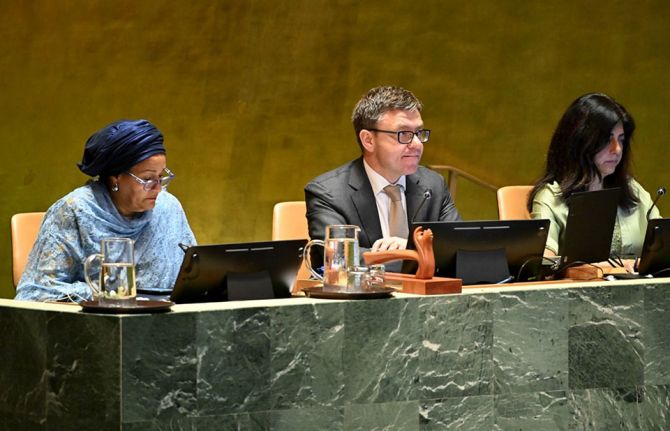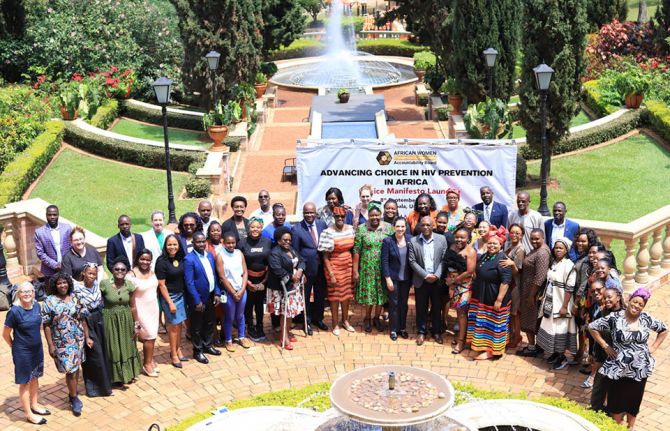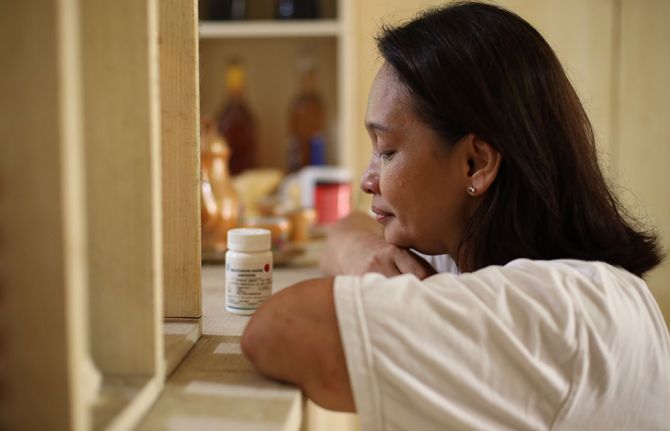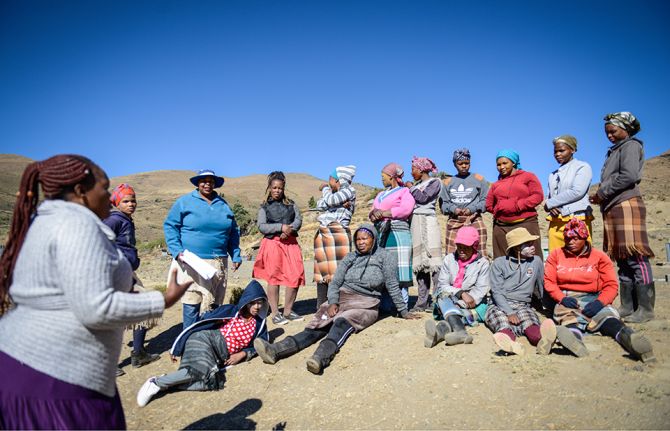Other Organizations

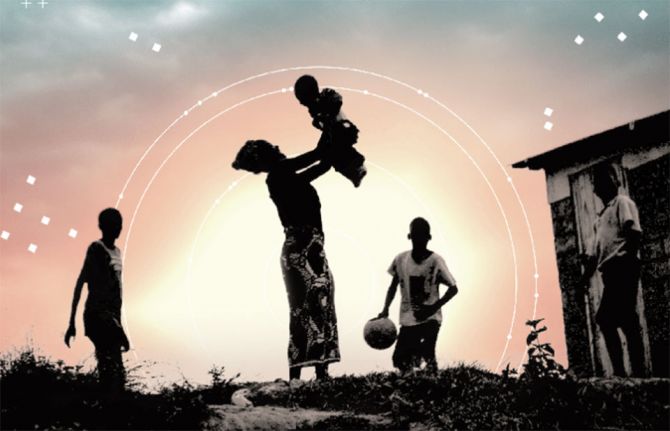
Press Release
Unfinished business: only the urgent and accelerated delivery of HIV services will keep the promise of ending AIDS in children by 2030
22 July 2024 22 July 2024Despite significant gains in many countries, critical gaps continue to undermine efforts to end AIDS in children
GENEVA/MUNICH, 22 July 2024—Despite progress made in reducing HIV infections and AIDS-related deaths among children, a new report released today by the Global Alliance for Ending AIDS in Children by 2030 shows that an urgent scale up of HIV services in countries worst affected by the pandemic is required to end AIDS by 2030.
The report, Transforming Vision Into Reality, shows that programmes targeting vertical transmission of HIV have averted 4 million infections among children aged 0-14 years old since 2000. Globally, new HIV infections among children aged 0-14 years old have declined by 38% since 2015 and AIDS-related deaths have fallen by 43%.
Among the 12 Global Alliance countries, several have achieved strong coverage of lifelong antiretroviral therapy among pregnant and breastfeeding women living with HIV, with Uganda nearing 100%, United Republic of Tanzania at 98%, and South Africa at 97%. Mozambique has achieved 90% coverage, with Zambia at 90%, Angola at 89%, Kenya at 89%, Zimbabwe at 88%, and Cote d'Ivoire at 84%.
“I applaud the progress that many countries are making in rolling out HIV services to keep young women healthy and to protect babies and children from HIV,” said UNAIDS Executive Director, Winnie Byanyima. “With the medicines and science available today, we can ensure that all babies are born – and remain – HIV-free, and that all children who are living with HIV get on and stay on treatment. Services for treatment and prevention must be ramped up immediately to ensure that they reach all children everywhere. We cannot rest on our laurels. The death of any child from AIDS related causes is not only a tragedy, but also an outrage. Where I come from, all children are our children. The world can and must keep its promise to end AIDS in children by 2030.”
Global Alliance countries are innovating to overcome barriers and accelerate progress towards ending AIDS in children. However, despite advances neither the world nor Global Alliance countries are currently on track to reach HIV-related commitments for children and adolescents and the pace of progress in preventing new HIV infections and AIDS-related deaths among children has slowed in recent years.
“Accelerating the delivery and uptake of HIV services for children and adolescents is a moral obligation, and a political choice,” said Dr Tedros Adhanom Ghebreyesus, Director-General of the World Health Organization. “Twelve countries are demonstrating they have made that choice, but significant challenges remain. While we have made progress in increasing access for pregnant women to testing and treatment to prevent vertical transmission of HIV, we are still far from closing the paediatric treatment gap. We need to further strengthen the collaboration and reach of the Global Alliance, and we must do this work with focus, purpose and in solidarity with all affected mothers, children, and adolescents.”
Around 120 000 children aged 0-14 years old became infected with HIV in 2023, with around 77 000 of these new infections occurring in the Global Alliance countries. AIDS-related deaths among children aged 0-14 years old numbered 76 000 globally with Global Alliance countries accounting for 49 000 of these unnecessary deaths. Vertical transmission rates remain extremely high in some locations, particularly in Western and Central Africa, with rates exceeding 20% in countries including Nigeria and the Democratic Republic of the Congo.
“In the fight against HIV, we must do a much better job for children,” said Peter Sands, Executive Director of the Global Fund to Fight AIDS, Tuberculosis and Malaria, which provides funding for HIV programmes in over 100 countries through a country-led partnership model. “In support of national programmes, we have been procuring the latest dolutegravir-based paediatric treatment regimens at negotiated prices. Our investments in laboratory systems are helping ensure exposed infants are rapidly tested and that those that test positive are quickly initiated on age-appropriate antiretroviral treatment. Differentiated testing and treatment approaches are helping close the diagnostic gap and ensuring more child-centred service delivery.”
It is concerning that the treatment gap between adults and children continues to widen.
“Just 57 per cent of children living with HIV receive life-saving treatment, compared to 77 per cent of adults,” said UNICEF Associate Director HIV/AIDS, Anurita Bains. “Without early and effective testing and treatment, HIV remains a persistent threat to the health and well-being of children and adolescents and puts them at risk of death. To close the treatment gap, we must support governments to scale up innovative testing approaches and ensure children and adolescents living with HIV receive the treatment and support they need.”
In 2023, there were 210 000 new infections globally among young women and girls aged 15—24 years old (130 000 in Global Alliance countries), four times higher than the 2025 goal set at 50 000. Preventing new infections among this age group is critical both to protect the health and wellbeing of young women and to reduce the risk of new infections among children.
Gender inequalities and human rights violations are increasing women’s vulnerability to HIV and diminishing their ability to access essential services. Globally, nearly one in three women have encountered some form of violence during their lifetime, with adolescent girls and young women disproportionately affected by intimate partner violence. In the four Global Alliance countries with available data, countries are not currently on track to achieve the target of ensuring that by 2025 less than 10% of women, key populations and people living with HIV experience gender-based inequalities and gender violence.
"It has been remarkable to see how many more children's lives can be saved when all stakeholders and partners come together to commit to end AIDS in children. While much progress has been made, notably through the successful introduction of pediatric dolutegravir, large gaps still remain across the pediatric cascade and we must recommit ourselves with purpose and innovation to fulfill the promises we have made by 2025 and beyond,” said Ambassador John N. Nkengasong, United States Global AIDS Coordinator and Special Representative for Global Health Diplomacy.
The Global Alliance for Ending AIDS in Children by 2030 was launched in 2022 by WHO, UNICEF and WHO to reinvigorate the paediatric HIV agenda. It has now grown, and in addition to the United Nations agencies, the alliance includes civil society movements, including the Global Network of People living with HIV, national governments in the most affected countries, and international partners, including PEPFAR and the Global Fund. Twelve countries are members: Angola, Cameroon, Côte d'Ivoire, The Democratic Republic of the Congo (DRC), Kenya, Mozambique, Nigeria, South Africa, Tanzania, Uganda, Zambia, and Zimbabwe.
UNAIDS
The Joint United Nations Programme on HIV/AIDS (UNAIDS) leads and inspires the world to achieve its shared vision of zero new HIV infections, zero discrimination and zero AIDS-related deaths. UNAIDS unites the efforts of 11 UN organizations—UNHCR, UNICEF, WFP, UNDP, UNFPA, UNODC, UN Women, ILO, UNESCO, WHO and the World Bank—and works closely with global and national partners towards ending the AIDS epidemic by 2030 as part of the Sustainable Development Goals. Learn more at unaids.org and connect with us on Facebook, Twitter, Instagram and YouTube.
Contact
UNAIDSMichael Hollingdale
hollingdalem@unaids.org
UNICEF
Lazeena Muna-Mcquay
lmunamcquay@unicef.org
WHO
Sonali Reddy
reddys@who.int
The Global Fund
Ann Vaessen
ann.vaessen@theglobalfund.org
PEPFAR
Veronica Davison
davisonv@state.gov

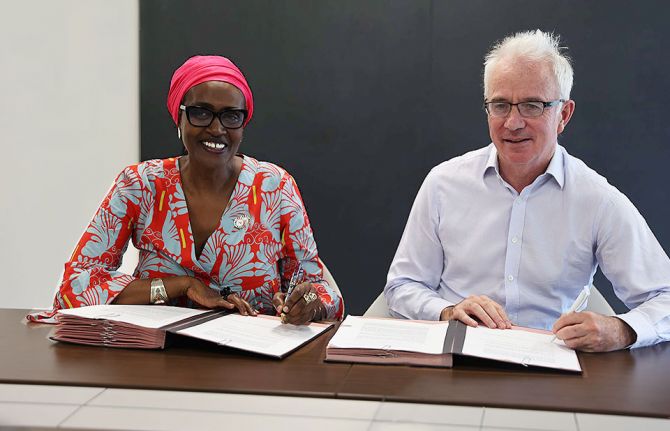
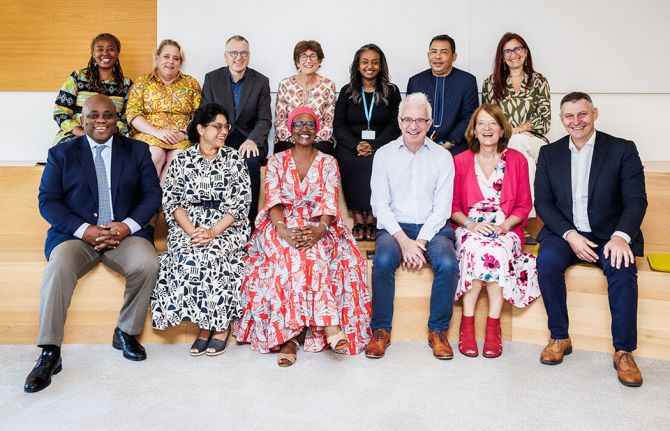
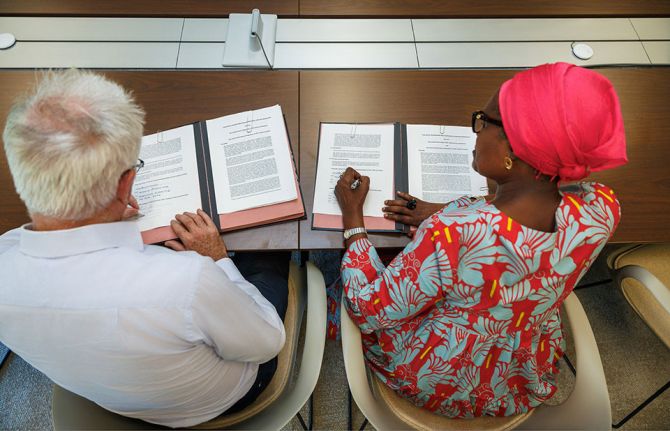
Press Release
UNAIDS and Global Fund sign a new strategic framework for their collaboration to end AIDS
24 June 2024 24 June 2024GENEVA, 24 June 2024— UNAIDS Executive Director, Winnie Byanyima, and Executive Director of The Global Fund to Fight AIDS, Tuberculosis and Malaria (the Global Fund), Peter Sands, signed a new strategic framework for cooperation and collaboration to end AIDS (2024 –2028). The agreement renews the organizations’ longstanding partnership and aligns ongoing collaboration with the most recent United Nations General Assembly Political Declaration on HIV and AIDS: Ending Inequalities and Getting on Track to End AIDS by 2030.
“The longstanding partnership between UNAIDS and the Global Fund has been instrumental in supporting many millions of people living with or vulnerable to HIV to enjoy better health and well-being through improved access to essential services,” said Winnie Byanyima, UNAIDS Executive Director. “We at UNAIDS are excited to continue building our collaboration with the Global Fund as we head toward our common goal of ending AIDS.”
The new strategic framework puts people and communities at the centre and aims to unite countries, communities and partners across and beyond the HIV response to take prioritized actions to accelerate progress towards the vision of zero new HIV infections, zero discrimination and zero AIDS-related deaths.
“Our strong collaboration, especially at country level, makes a huge difference in the fight against AIDS,” said Peter Sands, Executive Director of the Global Fund. “Our counterparts at UNAIDS play a crucial role on the ground: they help put communities living with and affected by HIV at the center of the response and ensure that rights-based approaches are widely adopted.”
The Global Fund Strategy (2023–2028) Fighting Pandemics and Building a Healthier and More Equitable World is fully aligned with the Sustainable Development Goals and UNAIDS’ Global AIDS Strategy (2021–2026) End Inequalities, End AIDS, which guides the global AIDS response. It calls on all actors to scale up and sustain global and domestic investments to achieve the strategy’s ambitious targets and commitments for 2025 as well as put the world on course to end AIDS as a public health threat by 2030.
Collaboration under the new agreement will focus on reducing the inequalities that drive the AIDS epidemic and closing the HIV prevention and treatment gaps that are preventing progress towards ending AIDS. It will also prioritize people who are not yet accessing life-saving HIV services.
The common approach supports a renewed focus on primary prevention, addressing structural drivers of HIV infection and AIDS-related deaths, and challenging inequities and human rights and gender-related barriers to services including stigma, discrimination and criminalization. It leverages new HIV prevention and treatment modalities, precision public health approaches, as well as support synergies between HIV services and related areas of health. In addition, the framework continues longstanding support to strengthen countries’ capacity to measure their epidemics and monitor their responses, and act on the data to drive results. There will also be a push for countries to map out the longer-term sustainability of the HIV response through stronger health systems, better-integrated services for HIV, and more streamlined donor contributions.
The Global Fund
The Global Fund is a worldwide partnership to defeat HIV, TB and malaria and ensure a healthier, safer, more equitable future for all. They raise and invest more than US$5 billion a year to fight the deadliest infectious diseases, challenge the injustice that fuels them, and strengthen health systems and pandemic preparedness in more than 100 of the hardest hit countries. They unite world leaders, communities, civil society, health workers and the private sector to find solutions that have the most impact, and they take them to scale worldwide. Since 2002, the Global Fund partnership has saved 59 million lives. Learn more at The Global Fund.
UNAIDS
The Joint United Nations Programme on HIV/AIDS (UNAIDS) leads and inspires the world to achieve its shared vision of zero new HIV infections, zero discrimination and zero AIDS-related deaths. UNAIDS unites the efforts of 11 UN organizations—UNHCR, UNICEF, WFP, UNDP, UNFPA, UNODC, UN Women, ILO, UNESCO, WHO and the World Bank—and works closely with global and national partners towards ending the AIDS epidemic by 2030 as part of the Sustainable Development Goals. Learn more at unaids.org and connect with us on Facebook, Twitter, Instagram and YouTube.
Contact
UNAIDSCharlotte Sector
sectorc@unaids.org
The Global Fund
Ann Vaessen
ann.vaessen@theglobalfund.org
Partner

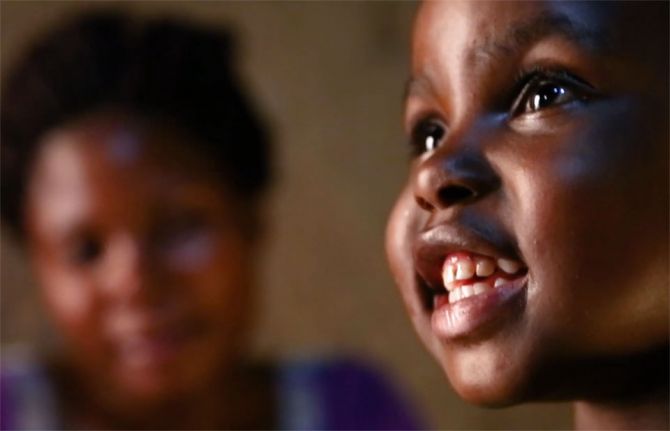
Press Release
UNAIDS urges sub-Saharan African countries and global partners to ensure children living with HIV are on life-saving treatment and to stop new infections
14 June 2024 14 June 2024GENEVA, 14 June 2024—On the International day of the African Child this 16 June, UNAIDS is urging African governments and global partners to provide treatment for children living with HIV and to stop new infections among children. The latest data show that only 56% of children living with HIV were on life-saving antiretroviral therapy in 2022 in sub-Saharan Africa compared to 83% of adults globally. Without access to treatment, 50% of infants living with HIV will die before their second birthday.
“As sub-Saharan Africa continues to carry the highest burden of HIV, children are not spared. Over 1.3 million children are living with HIV in the region and too many do not have access to life-saving treatment,” said Ms Winnie Byanyima, Executive Director of UNAIDS. “This highlights the urgency with which we need to tackle this pandemic among children and ensure access to life-saving treatment. No child should be left behind.”
Children are among the age group hardest to reach with HIV testing which is hampering efforts to diagnose and treat children living with HIV. Around 70 000 children died of AIDS-related illnesses in 2022 in sub-Saharan Africa because they did not have access to antiretroviral treatment.
In addition, many children are still becoming infected with HIV in sub-Saharan Africa. Across sub-Sharan Africa, around 110 000 children became infected in 2022 alone. While some countries like Namibia, which has recently reached a key milestone in the pathway toward eliminating vertical transmission of HIV and hepatitis B, are making fast progress, this is not the case in many other countries, particularly in Western and Central Africa including Nigeria, Ghana, Cameroon and the Democratic Republic of Congo which still account for some of the highest numbers of children newly infected with HIV.
“We know the path that ends AIDS. With all the science available, there is no reason for any child to die of AIDS in 2024. So too, we can ensure that all babies are born HIV free and stay HIV free. It is vital to ensure that pregnant and breastfeeding women have all the support they need to access medicine to avoid the transmission of HIV to babies while mothers are pregnant and breastfeeding,” said Ms Winnie Byanyima. “We need to redouble efforts in countries to end AIDS in children and close the HIV treatment gap between adults and children.”
Countries are working to end AIDS in children and this work is supported by the work of UNAIDS and its Cosponsors including UNICEF, the World Health Organization, and partners including PEPFAR, the Global Fund, the Elizabeth Glaser Pediatric AIDS Foundation (EGPAF), the Gates Foundation, Global Alliance to End AIDS in Children and others.
UNAIDS
The Joint United Nations Programme on HIV/AIDS (UNAIDS) leads and inspires the world to achieve its shared vision of zero new HIV infections, zero discrimination and zero AIDS-related deaths. UNAIDS unites the efforts of 11 UN organizations—UNHCR, UNICEF, WFP, UNDP, UNFPA, UNODC, UN Women, ILO, UNESCO, WHO and the World Bank—and works closely with global and national partners towards ending the AIDS epidemic by 2030 as part of the Sustainable Development Goals. Learn more at unaids.org and connect with us on Facebook, Twitter, Instagram and YouTube.
Related links


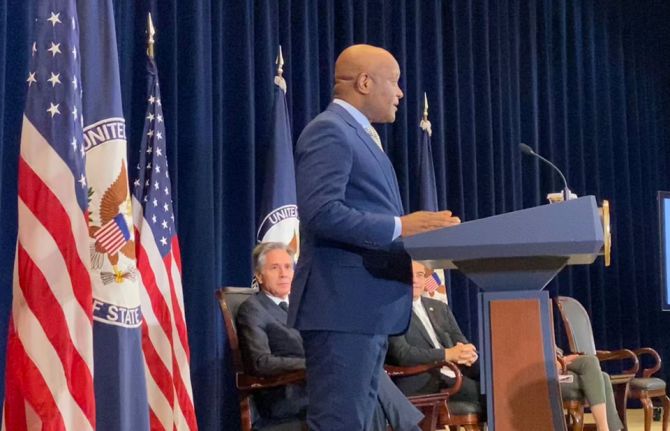
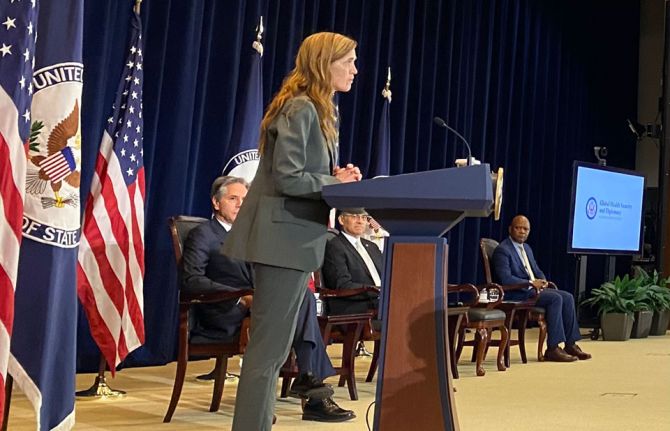
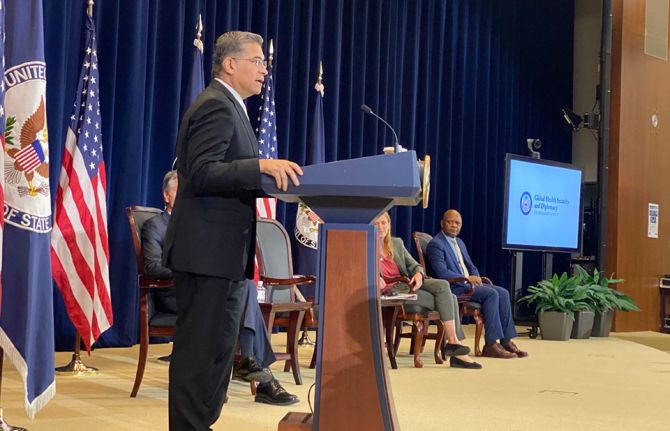
Press Statement
UNAIDS welcomes the launch of the Bureau of Global Health Security and Diplomacy at the U.S. Department of State
02 August 2023 02 August 2023WASHINGTON DC/GENEVA, 2 August 2023—UNAIDS welcomes the launch of the new U.S. Bureau for Global Health Security and Diplomacy which aims to strengthen the global health security architecture to effectively prevent, detect, control, and respond to infectious diseases, including HIV. The Bureau will be led by Ambassador John N. Nkengasong, serving as Ambassador-at-Large, U.S. Global AIDS Coordinator, and Senior Bureau Official for Global Health Security and Diplomacy, reporting directly to the U.S. Secretary of State.
“This new Bureau will seamlessly integrate global health security as a core component of U.S. national security and foreign policy,” said U.S. Secretary of State Antony Blinken at the launch in Washington D.C. The Bureau will also leverage and coordinate U.S. foreign assistance to promote international cooperation and seek to enhance protection for the U.S and globally against health threats through strengthened systems and policies. In his remarks Secretary Blinken highlighted the importance of working with colleagues in the U.S. Congress to secure a clean reauthorization of PEPFAR before September 2023.
During the event, Ambassador Nkengasong announced PEPFAR’s new Safe Births, Healthy Babies initiative—a new two-year US$ 40 million effort to accelerate progress to eliminate mother-to-child transmission of HIV in countries with high HIV burdens. The initiative will work in partnership with countries as well as the Global Alliance to End AIDS in Children and will add to ongoing partnerships between UNAIDS, PEPFAR, the Global Fund to Fight AIDS, Tuberculosis and Malaria and the World Health Organization that have led to high HIV burden countries achieving significant milestones on the pathway to eliminating mother to child transmission of HIV.
“With the creation of the new Bureau and the launch of the new Safe Births, Healthy Babies initiative, the U.S Government is making a strategic step forward to strengthen global health security, advance efforts on existing and future pandemics, and make solid commitments to the Sustainable Development Goal targets to end AIDS as a public threat by 2030,” said Dr Angeli Achrekar, UNAIDS Deputy Executive Director - Programme, UNAIDS.
The launch event featured remarks by Secretary of State Antony Blinken, Secretary of Health Xavier Becerra, USAID Administrator Samantha Power and Ambassador John N. Nkengasong, U.S. Global AIDS Coordinator and Senior Bureau Official for Global Health Security and Diplomacy.
UNAIDS
The Joint United Nations Programme on HIV/AIDS (UNAIDS) leads and inspires the world to achieve its shared vision of zero new HIV infections, zero discrimination and zero AIDS-related deaths. UNAIDS unites the efforts of 11 UN organizations—UNHCR, UNICEF, WFP, UNDP, UNFPA, UNODC, UN Women, ILO, UNESCO, WHO and the World Bank—and works closely with global and national partners towards ending the AIDS epidemic by 2030 as part of the Sustainable Development Goals. Learn more at unaids.org and connect with us on Facebook, Twitter, Instagram and YouTube.

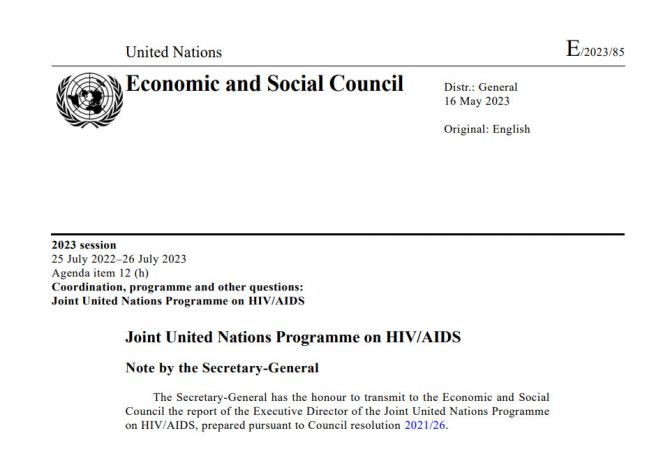
Feature Story
ECOSOC adopts its 2023 resolution on the Joint United Nations Programme on HIV/AIDS
03 August 2023
03 August 2023 03 August 2023On 25 July, the United Nations Economic and Social Council (ECOSOC) adopted its 2023 resolution on the Joint United Nations Programme on HIV/AIDS by consensus, at a meeting presided over by the Vice-President of ECOSOC, Ambassador Paula Narváez, Permanent Representative of Chile to the United Nations in New York.
At the meeting, the Council considered the 2023 report of the UNAIDS Executive Director, which was introduced by UNAIDS Deputy Executive Director for Programmes, Ms Angeli Achrekar.
Following the debate, Germany, presented a joint statement by Germany and Kenya introducing the 2023 Resolution on the Joint Programme. The two countries had co-facilitated the negotiations in Geneva, Switzerland, earlier in July in their capacity as, respectively, the Chair and Vice-Chair of the UNAIDS Programme Coordinating Board.
They emphasized their gratitude to Member States for having ensured a consensus resolution that stresses the need to act with urgency to meet the 2025 milestones and targets, as a prerequisite for ending the AIDS epidemic by 2030. The Resolution also notes the importance of the 2021 Political Declaration on HIV and AIDS as well as the Global AIDS Strategy 2021-2026.Other members taking the floor, including Australia, Brazil, the Islamic Republic of Iran, Mexico, South Africa, and the United States of America also commended the co-facilitators for the consultative process.
Germany and Kenya cautioned that despite continued global progress many countries are off track. They expressed concern about the persistent funding shortfalls experienced by the Joint Programme and its negative impact on the capacity to implement its annual workplan and called for renewed efforts to fully fund the core Unified Budget, Results and Accountability Framework, calling upon existing donors to maintain and step up their contributions, and inviting new donors to join from both the public and private sectors.
The resolution maintains its call for reinvigorated efforts to protect human rights and promote gender equality in the context of HIV, expressing concern over laws, policies, and practices that hinder access for all people to HIV prevention, treatment, care, and support service, and highlighted the attention needed by key populations, recognizing that efforts to achieve universal health coverage should be informed by the lessons learned from the multisectoral HIV response, including community-based and community-led service delivery. Members speaking from the floor also reiterated the importance of these lessons in preparation for and response to future pandemics.
“The inclusive and multisectoral Joint Programme model established by ECOSOC –which brings together the expertise of several eleven United Nations organizations and is governed by an inclusive Board that includes people most affected by HIV as its members – remains more relevant than ever. The important role of civil society in the AIDS response is recognized in the resolution you will be adopting today”, said Ms Achrekar, addressing the representatives of permanent missions in New York.
Related resources
Related

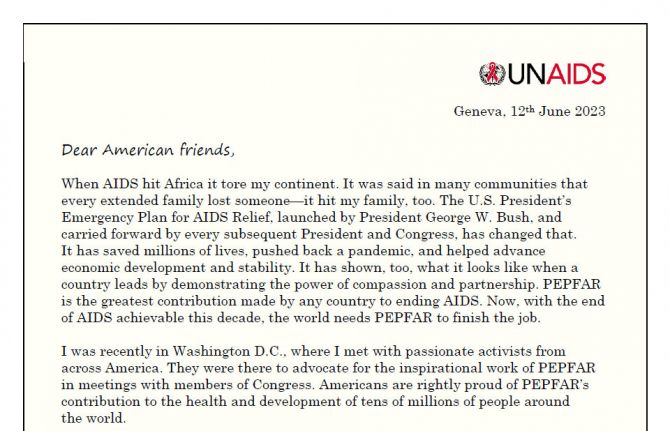
Feature Story
A Thank You letter to the American people from the Executive Director of UNAIDS: PEPFAR is the Greatest Contribution Made by Any Country to Ending AIDS
12 June 2023
12 June 2023 12 June 2023To mark the 20th Anniversary year of PEPFAR, UNAIDS Executive Director has written a letter to the American people.
You can read the text of her letter below. Click here to be able to view the actual letter.
Dear American friends,
When AIDS hit Africa it tore my continent. It was said in many communities that every extended family lost someone—it hit my family, too. The U.S. President’s Emergency Plan for AIDS Relief, launched by President George W. Bush, and carried forward by every subsequent President and Congress, has changed that. It has saved millions of lives, pushed back a pandemic, and helped advance economic development and stability. It has shown, too, what it looks like when a country leads by demonstrating the power of compassion and partnership. PEPFAR is the greatest contribution made by any country to ending AIDS. Now, with the end of AIDS achievable this decade, the world needs PEPFAR to finish the job.
I was recently in Washington D.C., where I met with passionate activists from across America. They were there to advocate for the inspirational work of PEPFAR in meetings with members of Congress. Americans are rightly proud of PEPFAR’s contribution to the health and development of tens of millions of people around the world.
In the last 20 years, the U.S. Government has invested more than US$110 billion to support the response to HIV and AIDS in 55 low and middle-income countries with the highest burden of HIV. The results that PEPFAR has helped make possible are remarkable—the rate of new HIV infections has fallen by almost half, AIDS-related deaths have been reduced by two thirds, and three-quarters of people living with HIV are on life-saving medicine. Millions of deaths have been prevented, and millions of babies have been born HIV-free.
Through the global HIV response, PEPFAR’s work has strengthened health and community systems, delivering broader outcomes for health, economic and human development and equity, accelerating progress towards achievement across the Sustainable Development Goals. Annually, PEPFAR has provided support and services through more than 70 000 facility and community health clinics; 3000 laboratories and nearly 30 national reference laboratories, as well as more than 340 000 health care and community workers. PEPFAR’s investment in health systems contributes significantly to national surveillance and health information capacities, which were critical to national COVID-19 responses and remain crucial for managing future pandemics and other public health threats.
PEPFAR has demonstrated the invaluable role of community engagement and civil society for advancing health and sustainable development, from helping faith-based organizations providing essential HIV care and support services across Africa, to ensuring support for Ukrainian civil society as the front-line of the national HIV response throughout the war.
As an important part of U.S. diplomacy, PEPFAR’s unflinching commitment to stand up against discrimination and inequities in HIV services sends a powerful signal that the world needs to ensure that nobody is left behind if we are to end AIDS.
PEPFAR works through partnerships. I look forward to my upcoming joint mission in Africa with PEPFAR and the Global Fund. At UNAIDS, which works on the ground in over 90 countries, including all 55 PEPFAR partner countries, we see the difference PEPFAR makes every day.
Twenty years ago, President Bush launched the creation of PEPFAR by announcing that “seldom has history offered a greater opportunity to do so much for so many”. In 2003, U.S. Congress moved swiftly to authorize PEPFAR within weeks. PEPFAR legislation was reauthorized in 2008, 2013 and 2018, with the bipartisan leadership and support of the U.S. Congress. With the lives of tens of millions of people hanging in the balance, countries, communities and UNAIDS are confident that we can rely on the American people, and that the U.S. Government and the U.S. Congress will continue to demonstrate unparalleled leadership through support for PEPFAR.
What was once a dream, but which PEPFAR’s partnership makes possible—the end of AIDS by 2030—is a reflection of the values of the American people. So today I wanted to write to you to say Thank You.
Yours,
Winnie Byanyima
UNAIDS Executive Director
Under-Secretary-General of the United Nations
Partners

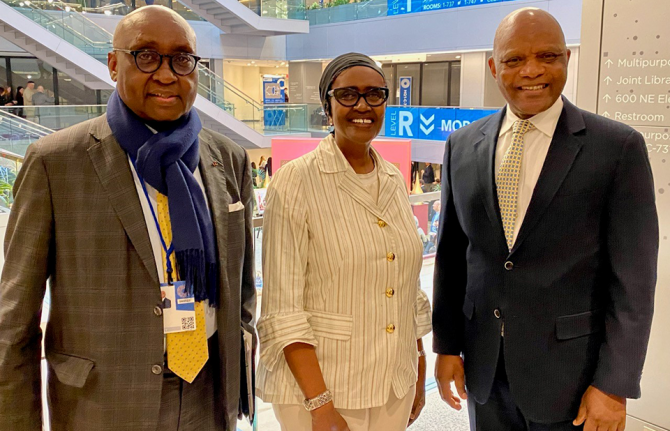
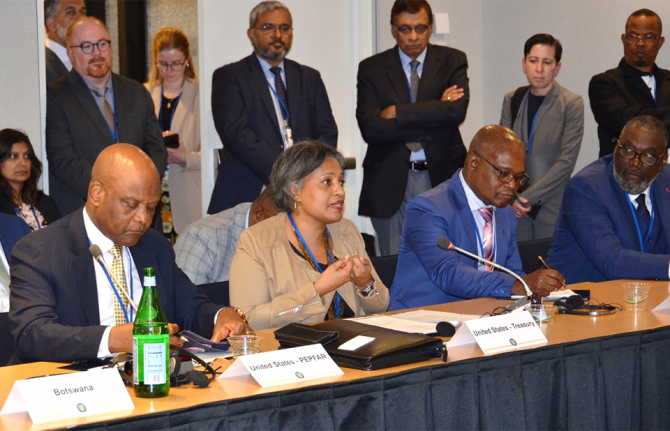
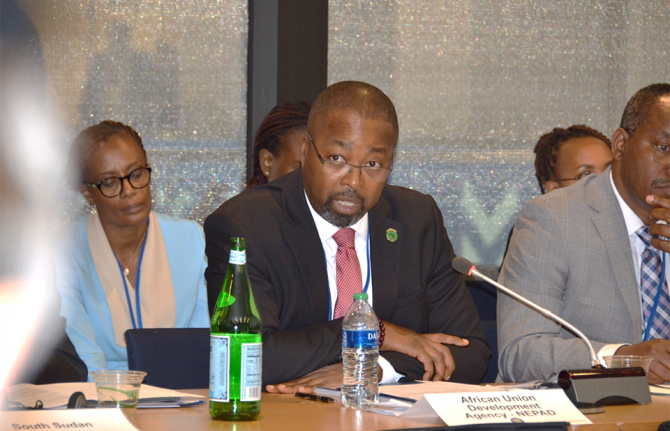
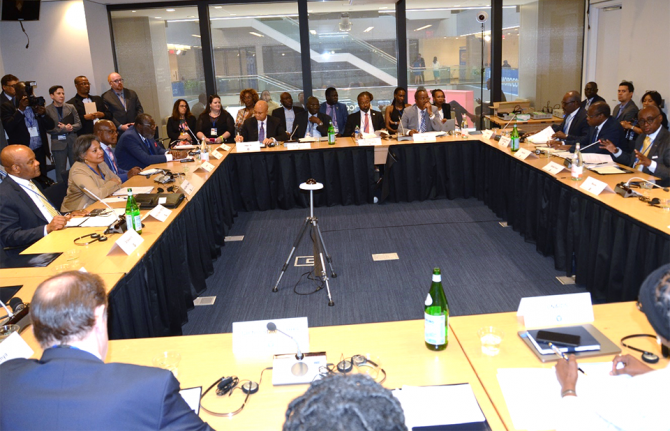
Feature Story
African ministers of finance join forces to highlight the importance of financial sustainability in the response to HIV
01 May 2023
01 May 2023 01 May 2023Although great strides have been made in tackling HIV in recent years, Africa remains the continent most affected by HIV and progress towards ending AIDS is stalling. The COVID-19 pandemic, global inflation, growing debt levels, and a retreat from overseas development assistance by some donors are hampering Africa’s efforts to ramp up national HIV responses and are jeopardizing broader outcomes for health, social development and economic growth.
UNAIDS estimates that globally, low and middle-income countries will need investments of US$ 29 billion annually to meet targets of ending AIDS as a public health threat by 2030. In 2021, only US$ 21.4 billion was spent on HIV responses low and middle-income countries.
In order to advance urgent and collaborative action to keep HIV high on political agendas and re-prioritize funding for health and HIV, African ministers of finance joined international partners on the sidelines of the World Bank / International Monetary Fund Spring meetings in Washington DC to explore ways to ensure financial sustainability of domestic HIV responses.
During the event, Ministers of Finance and senior representatives from Angola, Burundi, Democratic Republic of the Congo, Eswatini, Kenya, Lesotho, Nigeria, Mozambique, Rwanda, South Sudan, Tanzania and Uganda, and the Minister of Health of Côte d’Ivoire came together with global partners, including PEPFAR, the US Department of the Treasury, UNAIDS and the Global Fund to Fight AIDS, TB and Malaria.
Participants explored co-creating country-led paths towards the sustainability of the HIV response within broader health financing challenges. In the dialogue with Ministers of Finance, several issues were explored, among those, the need to overcome financing bottlenecks for HIV, expand local production of medicines and health technologies, or strengthen health systems and pandemics preparedness, while considering the relevance of developing joint HIV financial sustainability road-maps.
The event, ‘Investing in Sustainable HIV Responses for Broader Health Security and Economic Resilience in Africa’, was moderated by Donald Kaberuka, Chair of the Board of the Global Fund to Fight AIDS, Tuberculosis, and Malaria and the African Union’s High Representative for Financing, the Peace Fund and COVID-19 response. The event included remarks by;
- Alexia Latortue, Assistant Secretary for International Trade and Development, US Department of the Treasury,
- Dr. John N. Nkengasong, US Global AIDS Coordinator and Special Representative for Global Health Diplomacy, PEPFAR, US Department of State,
- Winnie Byanyima, Executive Director, UNAIDS, and
- Symerre Grey Johnson, Head of Regional Integration Infrastructure and Trade, New Partnership for Africa's Development (AU/NEPAD)
Participants also reflected on the finding of the recently released report by the Economist Impact, supported by UNAIDS, titled A Triple Dividend: The health, social and economic gains from financing the HIV response in Africa. The report provided evidence showing that fully financing the HIV response to get back on track to achieve the 2030 goals will produce substantial health, social and economic gains in 13 countries in sub-Saharan Africa.
This meeting was the first in-person discussion among ministers of finance and international partners around the sustainability of the HIV response held since COVID-19 travel restrictions were lifted. The meeting will be followed by a series of regional and in-country engagements to advance the financial, political and programmatic sustainability of the HIV response in preparation for the African Union’s Assembly of Heads of State Extraordinary Session on Ending AIDS by 2030.
Our work

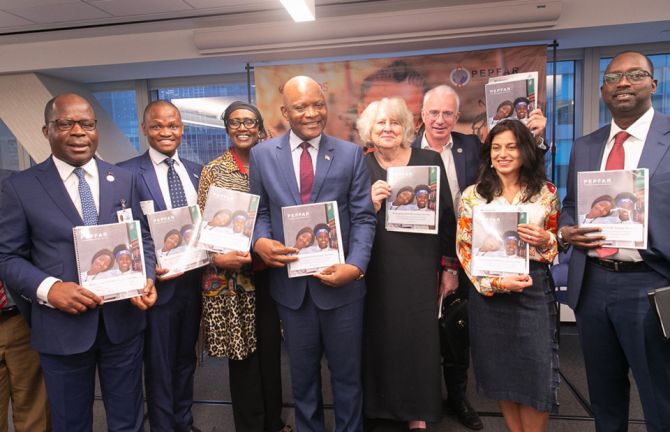
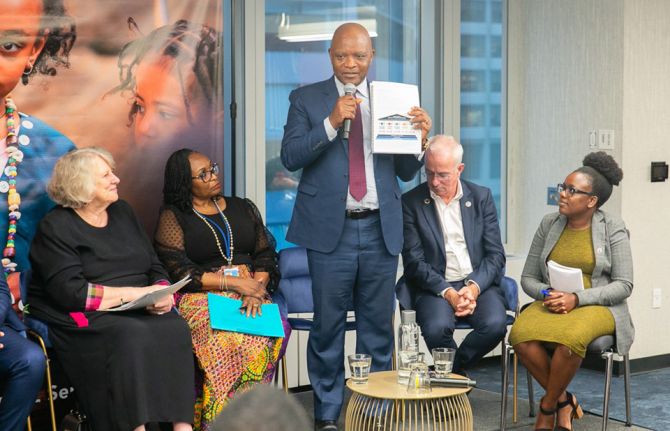
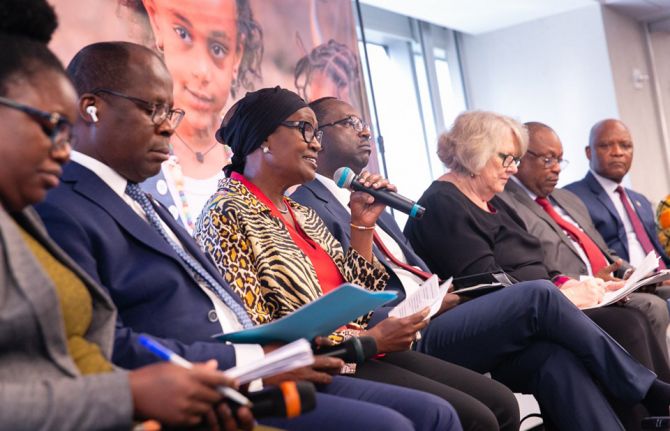
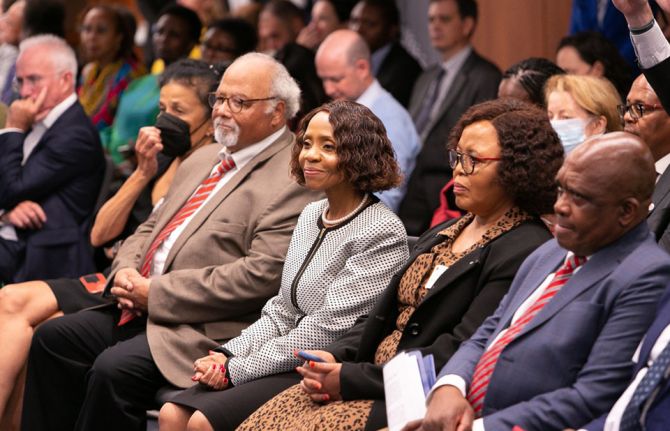
Press Release
African governments unite with UNAIDS, PEPFAR and global health partners to sustain political leadership to end AIDS and respond to future pandemics
28 September 2022 28 September 2022NEW YORK/GENEVA, 28 September 2022—During the high-level week of the 77th session of the United Nations General Assembly leading African Ministers of Health joined UNAIDS, PEPFAR, global health institutions and partners in New York in rallying to sustain their commitments to end AIDS and accelerate their response to current and future pandemics. The high-level side event on “Political Leadership in the HIV Response”, highlighted continued progress on combating HIV in sub-Saharan Africa, which has been largely sustained despite the added challenges of the COVID-19 pandemic.
Ambassador Dr. John Nkengasong, United States Global AIDS Coordinator and Special Representative for Health Diplomacy, who was celebrating his 100th day in office said, “The HIV response has defined global health for 25 years. We have made remarkable progress, but we still have remarkable challenges going forward to end AIDS. It is time to ask where we go from here. PEPFAR, the Global Fund and UNAIDS represent the best of humanity when we apply our minds to solving problems.”
Ambassador Nkengasong also took the opportunity to launch “Reimagining PEPFAR's Strategic Direction, Fulfilling America’s Promise to End the HIV/AIDS Pandemic by 2030”, which focuses on key priority areas including: health equity for priority populations including children, adolescent girls and young women, and key populations; long term sustainability; positioning platforms to not civil society front and centre; and leading with science.
“Our work continues with renewed urgency to accelerate our push to end AIDS by 2030,” said Winnie Byanyima, Executive Director of UNAIDS. “The actions needed to end AIDS are also key for overcoming other pandemics and for protecting ourselves against future threats. We can end AIDS by 2030. But the curve will not bend itself—we have to pull it down together.”
African governments were represented by Ministers of Health from Botswana, Côte d’Ivoire, the Democratic Republic of the Congo, Eswatini, Malawi, Rwanda and South Africa, and the Director of Public Health from Nigeria, speaking on behalf of H.E. President Buhari, and were joined by H.E. Neo Jane Masisi, the First Lady of Botswana.
The Minister of Health of Democratic Republic of the Congo, Jean-Jacques Mbungani, said, “Despite our many challenges, the Government made the fight against HIV a national priority. In one year, we increased our domestic funding for HIV from CDF10 billion to CDF15 billion, and from 2002 to 2020, we decreased AIDS-related mortality by 42%.”
The Minister of Health of Côte d’Ivoire, Mr Pierre Dimba highlighted the importance of integrating lessons from COVID-19 in the HIV response. “The COVID-19 pandemic showed how important it is to invest in health and enhance our focus on HIV,” said Minister Dimba. “We have reinforced our health systems and are reinforcing our network of community health workers to reach people most in need as well as working closely with the education sector.”
Rwanda has been investing in institutional reforms in the health sector and continues to increase its own domestic health funding. “For an effective management of domestic resources we created the Rwanda biomedical center which has a multifaceted approach,” said Daniel Ngamije, Minister of Health of Rwanda. “Rather than having individual programs for HIV, TB and malaria, we have created and financed a sustainable, integrated system.”
Senator Lizzie Nkosi, Minister of Health of Eswatini, expressed appreciation of the partnership with donors and technical partners as key to the country’s success in the HIV response.
Minister Nkosi used the event to announce impressive new results in Eswatini’s efforts to end AIDS. “Today I announce that Eswatini has reached the epidemic control and the 95-95-95 targets,” said Minister Nkosi. “We have committed significant resources for HIV, which we will continue, in spite of COVID-19 and other pandemics. However, we couldn’t have reached this success without PEPFAR, UNAIDS and the Global Fund and so many other partners.”
The Minister of Health of Botswana highlighted the remarkable results Botswana has achieved and recognized the strong continued support of partners in Botswana’s progress to end AIDS. “Partners have contributed a lot to our achievements. In the early days our population was about to be wiped out by HIV, but last year we celebrated surpassing the 95-95-95 targets – that would not have been possible without sustained political leadership at the highest levels and the long-term partnerships we have,” said Minister Dikoloti.
From South Africa, the country with the world’s largest HIV epidemic, Minister of Health Joe Phaahla called for accelerated momentum to end AIDS, and the urgency of halting HIV incidence, particularly in young people in South Africa. “We have reduced the incidence of HIV by over 45%, we now have 5.2 million people on HIV treatment, and we launched our HIV strategy with a focus on young people,” said Minister Phaahla. “Going forward, our focus will be on integrating programs—lessons which we have learned through COVID and HIV. When you’re under pressure to save lives, our key is integration—political leadership to mobilize leaders in all sectors, health workers and community health workers–bringing them onboard, and to maintain the momentum.”
Reading a statement from H.E President Buhari of Nigeria, Dr Morenike Alex-Okah, Director of Public Health for Nigeria highlighted the call to end paediatric AIDS, “I reiterate the Government of Nigeria’s full commitment to the Sustainable Development Goals and other international and regional initiatives towards ending AIDS by 2030, and to addressing current and future health emergencies. As a demonstration of commitment, my government will convene African leaders and our international partners in Abuja in November 2022 to launch the Global Alliance to end paediatric AIDS by 2025.”
Loyce Maturu from the Global Fund Advocates Network in Zimbabwe spoke about gaps in the HIV response. “We know that we haven’t done enough in the management of HIV in children, and to prevent HIV among adolescent girls and young women. We have to look at psychosocial support, mental health, and viral load monitoring, which have been missing when it comes to community engagement. We need to focus on HIV management at the community level, empower community-led monitoring, support families and strengthen community systems.”
Peter Sands, Executive Director of the Global Fund to Fight AIDS, Tuberculosis and Malaria expressed his appreciation for the support to the Global Fund at its 7th Replenishment which mobilized US$ 14.2 billion, “This is a great opportunity to say thank you to everyone who pledged contributions to the Global Fund, and particularly the implementing countries which have stepped up enormously,” said Mr Sands. “One of the great strengths of the HIV response was its relentless focus on outcomes, saving lives and reducing infections. One of the things we learned with COVID is that we have got to get smart at making investments that can serve multiple needs at once. A broader approach for health systems that can fight multiple diseases and cope with future threats.”
Dr Matshidiso Moeti, the World Health Organization’s Regional Director for Africa, highlighted the need for governments to pick up the pace to end AIDS in Africa. “This is a fantastic convening of leaders who will play a key role in ending AIDS in Africa,” said Dr Moeti. “With HIV, we have learned many lessons. Inequities continue to be a major factor in driving vulnerability to HIV and access to services. We can make the resources go further and achieve more results for HIV.”
Stéphanie Seydoux, France's Ambassador for Global Health concluded, “The time for implementation starts now. We know the way forward and that is country ownership, country investment.”
The event, “Political Leadership in the HIV Response”, was co-organized by UNAIDS and PEPFAR on the margins of high-level week of the 77th Session of the United Nations General Assembly in New York. The video of the event is available at: UNAIDS/PEPFAR High-Level Side Event.
PEPFAR
PEPFAR is the largest commitment by any nation to address a single disease in history. Managed and overseen by the U.S. Department of State, and supported through the compassion and generosity of the American people, PEPFAR has saved 20 million lives, prevented millions of infections, and helped transform the global AIDS response. The U.S. President's Emergency Plan for AIDS Relief - United States Department of State
UNAIDS
The Joint United Nations Programme on HIV/AIDS (UNAIDS) leads and inspires the world to achieve its shared vision of zero new HIV infections, zero discrimination and zero AIDS-related deaths. UNAIDS unites the efforts of 11 UN organizations—UNHCR, UNICEF, WFP, UNDP, UNFPA, UNODC, UN Women, ILO, UNESCO, WHO and the World Bank—and works closely with global and national partners towards ending the AIDS epidemic by 2030 as part of the Sustainable Development Goals. Learn more at unaids.org and connect with us on Facebook, Twitter, Instagram and YouTube.
Contact
UNAIDS New YorkSophie Barton Knott
tel. +41 79 514 6896
bartonknotts@unaids.org
PEPFAR Washington D.C.
Veronica Davison
tel. +1 202 285 5216
DavisonV@state.gov

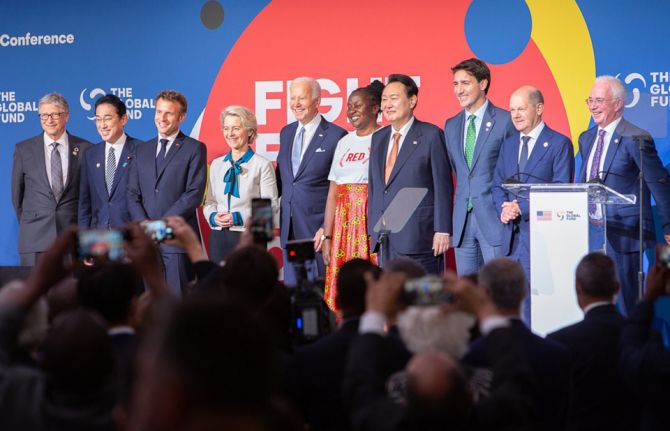
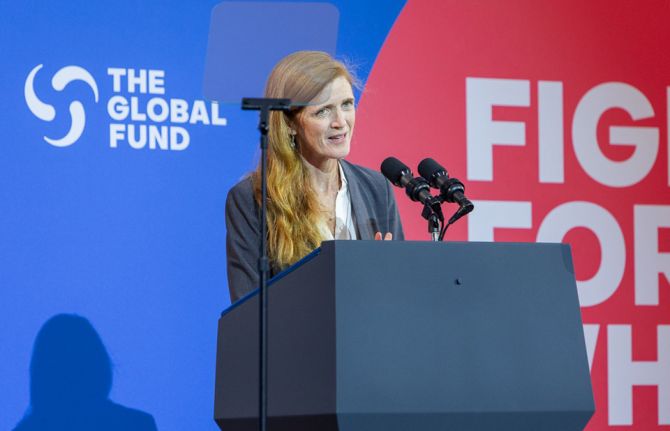
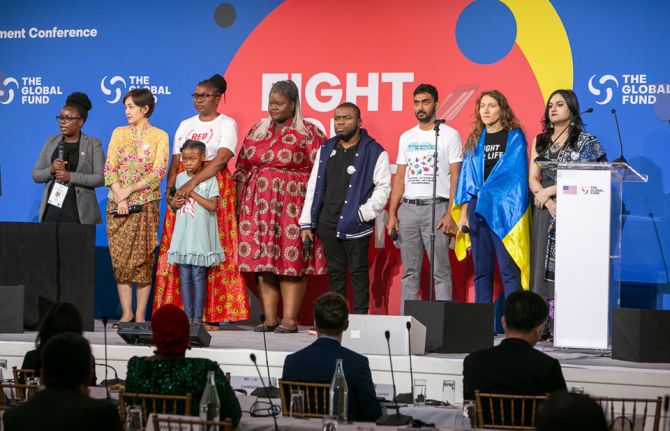
Press Release
UNAIDS applauds donors for pledging the largest amount ever to the Global Fund to Fight AIDS, Tuberculosis and Malaria
21 September 2022 21 September 2022High-income countries, private sector partners and developing countries, many with high HIV burdens, have all stepped up to fund the Global Fund
NEW YORK/GENEVA, 21 September 2022—UNAIDS congratulates donors for increasing their contributions to the Global Fund to Fight AIDS, Tuberculosis and Malaria (Global Fund). Donors pledged US$ 14.25 billion to support efforts to end the three pandemics with more funding set to come. Donors made their pledges at the Global Fund’s Seventh Replenishment Conference hosted by the President of the United States Joe Biden.
“Leaders from around the world who have committed resources today are life savers. They have made an investment in the future of children, young people and those facing the disproportionate burden of global inequalities—especially young women and girls. They are helping to build resilient health systems and be better prepared to face emerging threats to global security,” said Winnie Byanyima, Executive Director of UNAIDS.
Countries rose to the challenge of increasing funding by 30%, demonstrating their confidence in the strong leadership of the Global Fund and its partners. The United States continued its position as a leader in global health by pledging US$ 6 billion, committing to invest US$1 billion for every US$ 2 billion pledged by the rest of the world. Canada, Germany, Ireland, Japan, Luxembourg, Portugal, Spain and South Africa all increased their funding by 30%. A notable contribution came from the Republic of Korea which increased its contribution by 300% to US$ 100 million.
Developing countries, many tackling large HIV epidemics also stepped up in support of the Global Fund. Burkina Faso increased its contribution by 100%, Uganda and Togo increased by 50%, Kenya by 40% and Cote d’Ivoire by more than 30%. The Central African Republic, Eswatini, Malawi, Nigeria, Tanzania, Rwanda and Zimbabwe all made contributions to the Global Fund despite facing huge fiscal challenges, exacerbated by current global crises.
“I am truly humbled to see so many developing countries, that are themselves facing multiple crises, and yet still made increased pledges to the Global Fund. I commend them,” said Ms Byanyima.
France, the European Commission and the Bill and Melinda Gates Foundation all made important contributions to the Global Fund while Canada made an additional pledge of CAD 100 million for pandemic preparedness and called for increased financial contributions to UNAIDS and other partners working to end AIDS, TB and malaria.
Two major donors are still to pledge, the UK and Italy, both of whom reiterated their support to the Global Fund and indicated they will be pledging in the coming weeks. UNAIDS urges them to match the 30% increase of their peers to get closer to the Global Fund US$ 18 billion target.
This replenishment has mobilized the biggest global commitment to the Global Fund to date, in a context where challenging currency fluctuations made significantly increased contributions from European donors less visible when counting pledges in US dollars.
UNAIDS congratulates Donald Kaberuka, Chair of the Global Fund Board and Peter Sands, Executive Director of the Global Fund. This achievement is a strong endorsement of their leadership of the Global Fund by member states and private donors, and of our collective efforts to fight AIDS, TB and Malaria.
The HIV pandemic remains a global crisis claiming a life every minute but ending AIDS by 2030 is possible if countries continue to be bold in their financial contributions and work together to tackle inequalities. The actions needed to end AIDS will help protect the health and rights of everyone, strengthen economic development, and leave the world better prepared for future pandemic risks.
UNAIDS will continue to work closely with the Global Fund in a joint effort to end AIDS. Since the creation of the Global Fund in 2002, UNAIDS has supported more than 100 countries in leveraging and implementing Global Fund resources—ensuring the funds are available and reach people most in need.
UNAIDS
The Joint United Nations Programme on HIV/AIDS (UNAIDS) leads and inspires the world to achieve its shared vision of zero new HIV infections, zero discrimination and zero AIDS-related deaths. UNAIDS unites the efforts of 11 UN organizations—UNHCR, UNICEF, WFP, UNDP, UNFPA, UNODC, UN Women, ILO, UNESCO, WHO and the World Bank—and works closely with global and national partners towards ending the AIDS epidemic by 2030 as part of the Sustainable Development Goals. Learn more at unaids.org and connect with us on Facebook, Twitter, Instagram and YouTube.

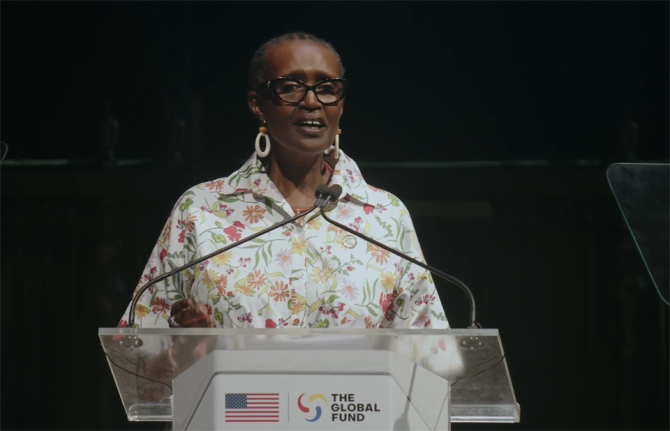

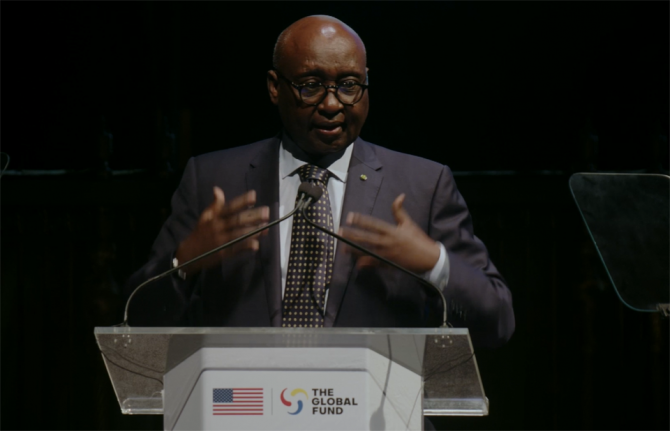
Press Release
UNAIDS urges donors to fully fund the Global Fund to Fight AIDS, Tuberculosis and Malaria to get the HIV response back on track
18 September 2022 18 September 2022NEW YORK/GENEVA, 18 September 2022—UNAIDS is calling on countries and donors to fully fund the Global Fund to Fight AIDS, Tuberculosis and Malaria by pledging a total of at least US$ 18 billion at the Seventh Global Fund Replenishment Conference hosted by President Biden in New York this week.
Speaking at the opening, on behalf of the United Nations family, the Executive Director of UNAIDS Winnie Byanyima said, “Millions of lives are at stake, along with the health of us all. A successful replenishment of the Global Fund to Fight AIDS, Tuberculosis and Malaria is essential to get the world on track to end three of today’s most devasting epidemics and instill resilience into national health systems capable of withstanding tomorrow’s shocks.”
In its July report, In Danger, UNAIDS revealed that the AIDS response is under serious threat from COVID-19 and the economic crisis, compounded by a continued decline in resources. It showed that while HIV infections should be continuing to decline in all countries, one in five of the world’s countries house rising new HIV infections. The rate of new infections globally only fell by 3.6% between 2020—2021, the smallest annual decrease since 2016.
The report showed that women and girls continue to be disproportionally affected. A new HIV infection occurred every two minutes among young women and girls aged 15—24 years old in 2021. Children are also being left behind—currently only around half (52%) of HIV-positive children were on life-saving medicines compared to 76% of adults.
“Now is the time for leaders to invest in their promise to end the AIDS epidemic by 2030 and to give children and young people a fighting chance at life,” said Ms Byanyima.
Since the Global Fund was established in 2002, UNAIDS has supported more than 100 countries to attract, implement and leverage Global Fund investments for HIV—making sure the money gets to people most in need. However, in recent years international solidarity in the fight against HIV has been weakening.
In 2021, international resources available for HIV were 6% lower than in 2010. The HIV response in low- and middle-income countries is US$ 8 billion short of the US$ 29 billion needed by 2025 to get the world on track to end the AIDS pandemic as a global health threat by 2030.
There are encouraging signs. The United States of America has announced that it will pledge US$ 6 billion to the Global Fund Replenishment contingent on the US$ 18 billion target being achieved in full. Other donors such as Germany and Japan have already announced increases of 30% in their funding pledges to the Global Fund for programmes covering the period 2024—2026. At its sixth replenishment conference, donors pledged US$ 14.02 billion to the Global Fund.
“This will be our most strategic step to get ahead in our fight against current and future pandemics, said Ms Byanyima. “The Global Fund’s model of responsive, inclusive and transparent funding will enable our collective success. But only if it is fully funded.”
UNAIDS
The Joint United Nations Programme on HIV/AIDS (UNAIDS) leads and inspires the world to achieve its shared vision of zero new HIV infections, zero discrimination and zero AIDS-related deaths. UNAIDS unites the efforts of 11 UN organizations—UNHCR, UNICEF, WFP, UNDP, UNFPA, UNODC, UN Women, ILO, UNESCO, WHO and the World Bank—and works closely with global and national partners towards ending the AIDS epidemic by 2030 as part of the Sustainable Development Goals. Learn more at unaids.org and connect with us on Facebook, Twitter, Instagram and YouTube.

